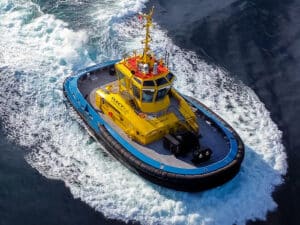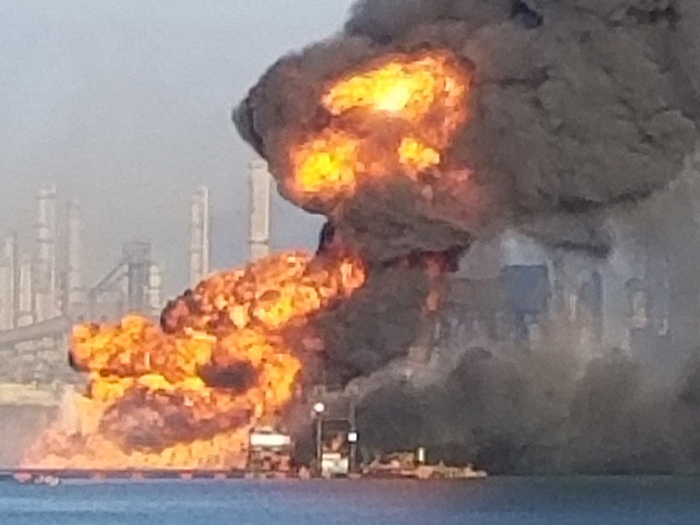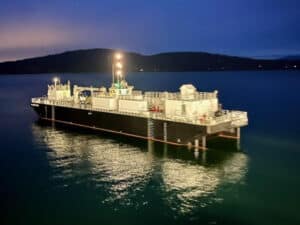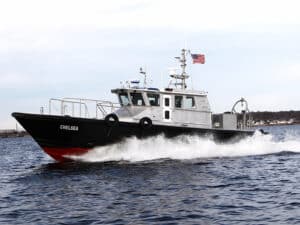
Deadly dredge strike on pipeline: NTSB makes 10 safety recs
Written by Nick Blenkey
Coast Guard crews responded to the dredge fire in the Port of Corpus Christi Ship Channel, Aug. 21, 2020. [U.S. Coast Guard photo]
The National Transportation Safety Board (NTSB) issued 10 safety recommendations Tuesday. They were made during a public board meeting held to determine the probable cause of the fatal August 21, 2020, hazardous liquid pipeline strike and subsequent explosion and fire aboard the dredge Waymon Boyd.
The NTSB says that the Waymon Boyd struck a submerged 16-inch hazardous liquid pipeline carrying propane during dredging operations in Corpus Christi, Texas. A geyser of propane gas and water erupted adjacent to the vessel. Shortly thereafter, propane gas engulfed the dredge and an explosion occurred. Fire damaged the vessel and surrounding shoreline.
A total of 18 personnel employed by Orion Marine Group were working or resting on the dredge and assist boats (tender boats, anchor barges, booster barges and a supply barge) on the day of the accident. Three crewmembers aboard the Waymon Boyd and one on an adjacent anchor barge died in the explosion and fire. Six crewmembers aboard the dredge were injured, one of whom later died from his injuries. The Waymon Boyd, owned by the Orion Marine Group, was a total loss valued at $9.48 million. The cost of pipeline damage was $2.09 million.
The Enterprise Products’ pipeline TX219 was struck by the Waymon Boyd’s rotating cutterhead, causing a breach in the line that allowed propane to escape and form a gas cloud that surrounded the dredge. Although the Waymon Boyd leverman attempted to swing the dredge away from the geyser of water that was carried with the escaping propane, the vessel was less than 200 feet away from the pipeline breach, and the expanding gas cloud enveloped it. Investigators concluded that propane gas released from the pipeline was drawn into the Waymon Boyd’s engineroom by the ventilation fans and was ignited, causing the explosion.
PROBABLE CAUSE
The NTSB determined the probable cause of the accident was Orion Marine Group’s inadequate planning and risk management processes, which failed to identify the proximity of its dredging operation to Enterprise Products’ pipeline TX219. This resulted in the absence of effective controls to prevent the dredge’s cutterhead from striking the pipeline.
Contributing to the accident, says the NTSB, were deficient dredging plans provided by Schneider Engineering and Consulting, which resulted in incomplete and inaccurate information communicated to Enterprise Products by Orion Marine Group during the one-call (call before you dig) process, which resulted in insufficient measures to protect the pipeline from excavation damage.
SAFETY ISSUES
The NTSB identified the following safety issues during its investigation: inadequate project planning and risk assessment, pipeline damage prevention, and pipeline hazard training.
As a result of the investigation, the NTSB issued three recommendations to the Pipeline and Hazardous Materials Safety Administration, one to Coastal and Marine Operators, two to Coastal and Marine Operators and the Council for Dredging and Marine Construction Safety, three to Orion Group Holdings and one to Enterprise Products.
The safety recommendations seek for the companies involved in the accident to implement or update policies and procedures for dredging near pipelines, and for a federal regulator and industry organizations to develop additional guidance and training specific to pipeline protection for marine dredging projects and to establish tolerance zone guidance for marine construction and dredging projects near pipelines.
“We have seen time and time again that tragedies happen when parties fail to have the appropriate policies and procedures in place for safety,” said Chair Jennifer Homendy. “Orion Marine Group’s inadequate planning led to this tragic event and cost lives. It is absolutely critical that when excavators conduct any dredging operations near underwater pipelines that proper precautions are in place to ensure safety.”
According to the report, NTSB concluded that marine dredging projects require a greater level of collaboration and review between pipeline operators and dredging companies than the one-call process provides because of the challenges associated with marking marine pipelines and the lack of precision associated with dredging operations. In addition, third-party damage prevention efforts would be improved if dredging companies obtained accurate location data from pipeline operators for pipelines within and near dredging project boundaries to incorporate into dredge control software files.
The executive summary, probable cause, findings, and safety recommendations are in the report abstract available on the investigation web page.
The final report will be published on the NTSB website in several weeks.
RECOMMENDATIONS
To Pipeline and Hazardous Materials Safety Administration:
- In collaboration with Coastal and Marine Operators and the Council for Dredging and Marine Construction Safety, develop recommended practices and processes for pipeline operators and dredging companies to obtain and use accurate pipeline location data during planning and one-call locating activities for pipelines both in and near project locations.
- In collaboration with Coastal and Marine Operators and the Council for Dredging and Marine Construction Safety, develop guidance for excavators to clearly identify proposed dredging boundaries for dredging projects before notifying one-call centers by either physically marking the boundaries where practicable, or identifying the boundary with accurate location data.
- Include criteria for minimum tolerance or safety zones for dredging in state pipeline safety program evaluation guidelines.
To Coastal and Marine Operators:
- Modify the existing Working Safely Near Underwater Pipelines online pipeline safety training to incorporate lessons learned from this accident.
To Coastal and Marine Operators and the Council for Dredging and Marine Construction Safety:
- Work with the Pipeline and Hazardous Materials Safety Administration to develop recommended practices and processes for pipeline operators and dredging companies to obtain and use accurate pipeline location data during planning and one-call locating activities for pipelines both in and near project locations.
- Work with the Pipeline and Hazardous Materials Safety Administration to develop guidance for excavators to clearly identify proposed dredging boundaries for dredging projects before notifying one-call centers by either physically marking the boundaries where practicable or identifying the boundary with accurate location data.
To Orion Group Holdings:
- Require Orion Marine Group to, for all future dredging projects, conduct a formal, documented risk assessment with risk analysis, such as a risk matrix, before starting work, and based on the risk assessment, develop a hazard control plan.
- Require Orion Marine Group to develop standardized, written policies and procedures for planning dredging operations near pipelines that include pipeline operator engagement on pipeline avoidance measures, minimum tolerance zones, minimum requirements for marking and verifying pipelines, and uploading of pipeline information into DREDGEPACK or other navigation software.
- Require Schneider Engineering and Consulting to develop specificationsand quality control measures to ensure pipeline and other hazard data is included and clearly represented in engineering plans and drawings, to include depicting tolerance distances from underwater pipelines.
To Enterprise Products:
10.Revise your damage prevention program guidelines to include a larger tolerance zone for dredging operations.




